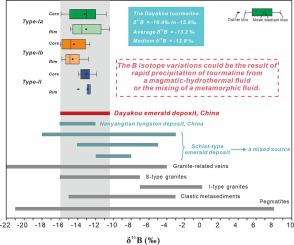Ore Geology Reviews ( IF 3.2 ) Pub Date : 2021-05-01 , DOI: 10.1016/j.oregeorev.2021.104208 Zhengyu Long , Xiaoyan Yu , Yuyu Zheng

|
The Cretaceous Dayakou emerald deposit (southwest China) hosted in the Neoproterozoic schists and granofels is a magmatic-hydrothermal ore system. In this paper, we present the petrological and geochemical study of tourmaline from the Dayakou deposit, aiming to constrain the source of ore-forming fluid and emerald genesis. Two types of tourmaline, namely type-I formed in emerald-bearing quartz veins and type-II in non-mineralized quartz veins, are distinguished and analyzed in situ for their chemical and boron isotopic compositions. All tourmalines are close to the dravite endmember and belong to the alkali group. The type-I tourmaline has a higher Fe/(Fe + Mg) ratio (0.28–0.47) with Li enrichment (21–227 ppm). The type-II tourmaline, however, shows a lower Fe/(Fe + Mg) ratio (0.14–0.34) with relatively higher Co (2–3 ppm) and REEs (2–21 ppm) content. Boron isotopic composition in tourmaline (δ11B = −15.8‰ to −10.4‰) is closed to the average boron composition of continental crust. The boron isotope variations could be the result of rapid precipitation of tourmaline from a magmatic-hydrothermal fluid or the mixing with a metamorphic fluid. Based on the chemical composition and enrichment in granitophile elements (e.g., Li, Be, Sn) and transition metals (e.g., Ti, V, Cr) in tourmaline, we propose that the Dayakou deposit is dominantly controlled by the fluid-rock interaction between the metamorphic basement and possibly reduced magmatic-hydrothermal fluids. Beryllium is transported as fluoride complex in fluids. Hydrothermal fluids continuously interacted with surrounding rocks to extract Cr, V, and Ca into fluids, resulting in extensive crystallization of fluorine minerals (e.g., fluorite, fluorapatite, etc.) and subsequent destabilization of Be-F complexes. The large amounts of Be, Cr and V enriched in the fluid then combine to form emeralds. The Li, Co, and REEs contents of tourmaline can be used as the exploration indicator to target emerald mineralization in this region.











































 京公网安备 11010802027423号
京公网安备 11010802027423号